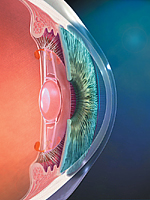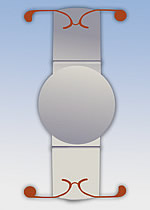Refractive Lens Exchange (RLE)
Definition
 Refractive lens exchange (RLE) is a refractive surgery procedure in which the crystalline lens of the eye is removed and replaced with an artificial lens implant
to correct refractive error. RLE surgery is essentially the same as cataract surgery; however, in RLE, the procedure is performed primarily to change the refractive properties of the eye rather than to remove a cataract that has developed in the lens of the eye.
Refractive lens exchange (RLE) is a refractive surgery procedure in which the crystalline lens of the eye is removed and replaced with an artificial lens implant
to correct refractive error. RLE surgery is essentially the same as cataract surgery; however, in RLE, the procedure is performed primarily to change the refractive properties of the eye rather than to remove a cataract that has developed in the lens of the eye.
How Does RLE Work?
In hyperopic (farsighted) or myopic (nearsighted) patients, the light coming into the eye is not focused properly on the retina. This poor focus may be due to the eye's crystalline lens either being too weak or too strong to help focus light appropriately. By removing the eye's crystalline lens and replacing it with an artificial lens the light is able to focus better on the retina and therefore reduces the person's dependence on glasses and contact lenses. The artificial lens that is placed in the eye, called an intraocular lens (IOL), can be chosen depending on the refractive needs of the patient's eye.
Who are candidates for RLE?
RLE is most commonly used for middle age and older hyperopic (farsighted) patients that have higher levels of farsightedness than can effectively be treated with LASIK or PRK. These individuals are typically also presbyopic. Additionally, some patients also have a mild degree of cataract; the cataract may not be causing symptoms currently, but will probably progress and cause vision problems in the future. In these patients, exchanging the natural crystalline lens of the eye for a multifocal lens may help correct both the farsightedness and the presbyopia symptoms. Monofocal lens implants can also be used for these patients. RLE can also be used for myopic (nearsightedness) people who otherwise are not candidates for LASIK or PRK as well as patients with astigmatism.
 In general, candidates for RLE should be:
In general, candidates for RLE should be:
- 21 years of age or older: younger people may still have eyes that are growing.
- Dissatisfied with wearing glasses or contact lenses.
- Have had no change in glasses or contact lens prescription for at least a year.
- Have otherwise healthy eyes.
- Be willing to accept a small amount of risk associated with surgery.
- Understand that glasses and/or contacts are occasionally still needed for some activities after surgery.
These conditions may prevent you from undergoing RLE or other refractive surgeries. You should alert your eye surgeon if you have one or more of these conditions so that he or she can help you make the best choice about undergoing refractive surgery:
Condition:
Reason for caution:
Examination prior to RLE
Before you arrive at the doctor's office
If you wear contact lenses you must stop wearing them prior to surgery–at least two weeks for soft contacts and one month for hard contacts. This is because contact lenses can cause mild warping of the corneal shape, which may interfere with the preoperative measurements of the eye and calculations for RLE surgery.
Tests you may have at the doctor's office
The evaluation for PRK, RLE surgery typically includes a complete eye exam of the front and back of the eye, plus several additional tests including:
- Your vision with and without glasses will be tested, as well as a refraction to determine if your current vision differs markedly from the vision corrected in your current glasses. If they do differ markedly, you may need to return for another visit several weeks later for a repeat refraction to insure that your prescription is not changing.
- Your doctor will perform a slit lamp examination to inspect your eye and lens.
- A retinal exam may also be performed during the dilated examination.
- And a second refraction may be performed after your eyes have been dilated.
- Lastly, measurements of the curvature of your cornea and length of your eye will be taken to help your doctor choose the appropriate lens implant for your eye.
Is 20/20 vision guaranteed with RLE?
RLE surgery is an extremely advanced technology for surgical vision correction. The excimer laser is one of the most precise instruments available for use in modern medicine, and it can be programmed to match the exact refractive correction your eye needs to see well. As such, the vast majority of people undergoing RLE surgery are very happy with their post-procedure vision. In fact, a person's happiness with their vision after the procedure is a far more important measure of success than the somewhat arbitrary "20/20" measurement done in a dark room of a doctor's office.
However, several factors may lead to a person still needing additional help from glasses or contact lenses post-surgery. Though very precise measurements and surgical technique are used for RLE surgery, the individual healing response of each patient may result in some variability of the final refractive outcome. Generally, though, this variability is very small and people are highly satisfied with the surgery. LASIK or PRK may sometimes be used after RLE to "touch up" any residual refractive error. Occasionally, though, glasses or contacts will still be needed for some viewing situations after RLE surgery.
What are the risks of RLE surgery?
Though the risks of RLE surgery are small, vision can be lost in several ways:
Infection
Since cuts are made on the eye, it is possible that bacteria could gain access to the corneal tissue and cause an infection. Scarring from such an infection could lead to vision loss. This is very uncommon as powerful antibiotics are used after RLE to prevent infection. The risk of severe infection is less than 1 in 500.
Swelling of the Cornea or Retina
Swelling of eye structures can occur after RLE surgery. Generally, these are mild and self-limited problems that resolve with time and eye drop treatments. Rarely, though, swelling may persist and lead to decreased vision. Additionally surgical methods are available to help in those cases.
Retinal Detachment
Rarely, surgery inside the eye can cause small retinal tears to occur that could lead to a retinal detachment. Usually, a patient will experience flashes of light and multiple new floaters if a tear occurs. Lasers and surgery can be used to repair retinal tears and retinal detachments that occur after lens removal surgery.
Increased Eye Pressure
High eye pressure may occur after lens removal surgery. Usually, this resolves within a few days, although sometimes medication is needed to keep pressure low.
Posterior Capsule Opacification
Several months after RLE surgery about 10-20% of patients develop posterior capsule opacification (PCO). In this condition, a fine, hazy film develops on the back side of the prosthetic lens implant, which may cause a gradual decline in vision or glare symptoms. Your surgeon can remove this film and restore the vision with a simple, in-office laser procedure, called YAG Capsulotomy.
What will I experience during the RLE procedure?
On the morning of your procedure, your surgeon will ask you not to wear any makeup (which may stain the cornea) or perfume or cologne. At the laser surgery center, you will usually be given an intravenous line (IV) so that Valium and pain medication can be given during the surgery. The RLE procedure itself usually takes about 20 minutes or less to perform. An injection of numbing medicine may be given behind the eye while you are partially asleep, or eye drops may also be used to numb the eye.
During RLE surgery, small incisions, usually less than 3 mm long, are made at the edge of the cornea. The crystalline lens is then broken into small pieces and removed with an ultrasound process called phacoemulsification.
Next, the plastic or silicone prosthetic lens is inserted into the eye into the same space formerly occupied by the crystalline lens. This prosthetic lens stays in the eye permanently, and works to focus light on the retina again. During the surgery, you may see bright and multi-colored lights as well as blurry shapes moving in front of the eye. Generally, you will feel calm and comfortable during the surgery from the intravenous medications. The wounds in RLE surgery are so small that they typically do not require a suture to close them at the end of the surgery. Last, antibiotic eye drops are administered, and a patch or plastic shield may be placed on your eye after the surgery, though sometimes a patch is not needed.
After the procedure is complete, you will rest in the recovery area for an hour or two, after which someone can drive you home. As you have had intravenous medications, driving yourself to and from the surgery center will not be allowed. Your eye may start to burn and feel irritated about an hour after the surgery as the numbing medicine wears off. Artificial tears can help make the eye feel more comfortable. Your surgeon may also have you start antibiotic and ibuprofen drops on the evening after your surgery as well.
After your surgery, you should not rub or press on the eye for at least 1 to 2 weeks. Gentle cleaning around the eye with a damp washcloth or cotton ball is fine though. Avoid lifting objects that weigh more than 20 to 30 lbs and refrain from heavy activity for at least 1 to 2 weeks. Also avoid bending at the waist to pick up objects on the ground for the same period of time. These measures help to avoid putting excess pressure on the eye, which may open the wound before it is healed. Also be sure to avoid getting soapy or dirty water in the eye, and do not swim or use hot tubs for at least 2 weeks after the surgery.
Your doctor will see you the next day, at which point the eyes are typically feel pretty comfortable. You will continue using eye drops for several weeks after the surgery, and then see your doctor again in 1 to 3 weeks for a vision check. If all is well your doctor will see you again in 6 months to a year for another vision check.

